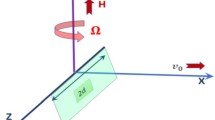Abstract
The inverse problem of determining time-variable surface heat flux in a plane wall, with constant or temperature dependent thermal properties, is numerically studied. Different kinds of incident heat flux, including rectangular waveform, are assumed. The solution is numerically solved as a function estimation problem, so that no a priori information for the functional waveforms of the unknown heat flux is needed. In all cases, a solution in the form of a piece-wise function is used to approach the incident flux. Transient temperature measurements at the boundary, from the solution of the direct problem, served as the simulated experimental data needed as input for the inverse analysis. Both direct and inverse heat conduction problems are solved using the network simulation method. The solution is obtained step-by-step by minimising the classical functional that compares the above input data with those obtained from the solution of the inverse problem. A straight line of variable slope and length is used for each one of the stretches of the desired solution. The influence of random error, number of functional terms and the effect of sensor location are studied. In all cases, the results closely agree with the solution.







Similar content being viewed by others
Abbreviations
- a, b:
-
constant in Eq. 19
- c e :
-
specific heat, J kg−1 C−1
- C :
-
capacitor, F
- e :
-
average relative error in Eq. 24
- F :
-
functional defined in Eq. 18
- G :
-
voltage-control current source
- h :
-
heat transfer coefficient, W m−2 C−1
- J :
-
electric current variable, A
- j :
-
heat flux rate, W m−2
- j1, j2:
-
constants
- k :
-
thermal conductivity, W m−1 C−1
- K :
-
constant in computational procedure
- L :
-
thickness of the slab
- n :
-
first value of temperature within the functional
- N :
-
number of volume elements
- r :
-
regularisation parameter
- R :
-
resistor
- t :
-
time, s
- t 1 :
-
constant
- T :
-
temperature, C
- V :
-
voltage, V
- x :
-
spatial co-ordinate
- δ:
-
convergence criteria
- ε:
-
random error value
- σ:
-
standard deviation
- μ:
-
random variable
- ρ:
-
density, kg m−3
- ω:
-
angular frequency
- Δx:
-
thickness of the control volume
- Δt:
-
time interval temperature measurement
- sur:
-
surrounding medium
- C:
-
referred to the capacitor
- d :
-
number of iterations
- f :
-
referred to particular location at the slab
- est:
-
values estimated of fluxes
- exact:
-
values exacts of fluxes
- i :
-
connected to the volume element i, 1≤ i≤ N; also, centre of the volume element
- i±Δ:
-
right and left ends of the volume element
- in:
-
incident
- inv:
-
refers to the solution of the inverse problem
- s :
-
1, 2, ..., m
- m :
-
natural number (total number of temperature measurements)
- n :
-
refers to the first temperature with the stretch
- o:
-
associated to the initial condition
- z :
-
1, 2,... Z, in Eq. 18
- Z :
-
number of stretches of the piece-wise function in the IHCP
- ∞:
-
value infinite
References
Stolz G Jr (1960) Numerical solution to an inverse problem of heat conduction for simple shape. J Heat Transfer T ASME 82:20–26
Burggraf OR (1964) An exact solution of the inverse problem in heat conduction theory and publications. J Heat Transfer T ASME 86C:373–382
Sparrow EM, Haji-Sheikh A, Lundgren TS (1964) The inverse problem in heat conduction. J Appl Mechanics 32(3):369–375
Beck JV (1968) Surface heat flux determination using an integral method. Nucl Eng Des 7:170–178
Beck JV, Blackwell B, St Clair CR Jr (1985) Inverse heat conduction, ill-posed problems. Wiley-Interscience, New York
Alifanov OM, Mikhailov VV (1978) Solution of the nonlinear inverse thermal conductivity problem by the iteration method. Translated Inzhenerno-Fizicheskii Zhurnal 35(6):1123–1129
Hills RG, Hensel EC Jr (1986) One-dimensional nonlinear inverse heat conduction technique. Numer Heat Transfer 10:369–393
Kurpisz K (1991) Numerical solution of one case inverse heat conduction problem. J Heat Transfer 113:280–286
Huang CH, Özisik MN (1992) Inverse problem of determination unknown wall heat flux in laminar flow through a parallel plate duct. Num Heat Transfer A 21:55–70
Park HM, Chung OY (1999) Inverse natural convection problem of estimating wall heat flux using a moving sensor. J Heat Transfer 121:828–836
Alhama F, Zueco J, González-Fernández CF (2003) An inverse determination of unsteady heat fluxes using a network simulation method. J Heat Transfer 125(6):1178–1183
González-Fernández CF, Alhama F, López Sánchez JF, Horno J (1998) Application of the network method to heat conduction processes with polynomial and potential-exponentially varying thermal properties. Numer Heat Transfer A 33:549–559
Alhama F, González-Fernández CF (2002) Transient thermal behaviour of phase-change processes in solid foods with variable thermal properties. J Food Eng 54:331–336
Statistic for Windows 2.0 (1986)
Pspice 6.0. (1994) Microsim Corporation, 20 Fairbanks, Irvine, California 92718
Chantasiriwan S (1999) Comparison of three sequential function specification algorithms for the inverse heat conduction problem. Int Commun Heat Mass Transfer 26(1):115–124
Zueco J, Alhama F, González-Fernández CF (2003) An inverse problem to estimate temperature dependent heat capacity under convection processes. Heat Mass Transfer 39(7):599–604
Zueco J (2003) Solution of inverse heat conduction problem by means of the network simulation method. PhD Thesis, Technical University of Cartagena (in Spanish)
Huang CH, Yan JY, Chen HT (1995) Function estimation in predicting temperature-dependent thermal conductivity without internal measurements. J Therm Heat Transfer 9(4):667–673
Author information
Authors and Affiliations
Corresponding author
Rights and permissions
About this article
Cite this article
Zueco, J., Alhama, F. & González Fernández, C.F. Numerical nonlinear inverse problem of determining wall heat flux. Heat Mass Transfer 41, 411–418 (2005). https://doi.org/10.1007/s00231-004-0553-1
Received:
Published:
Issue Date:
DOI: https://doi.org/10.1007/s00231-004-0553-1




